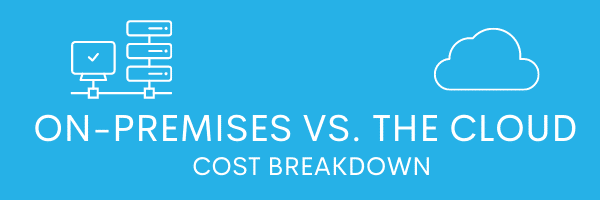
Start-Up Costs

If you’re just starting out creating a network or application-hosting environment and wondering whether cloud or on-prem will be cheaper in terms of start-up costs, it is most likely the cloud will be the cheaper way to go.
Between the investments in hardware, space, and power that you’d need to have a well-running environment, on-prem winds up being more expensive. Not to mention the labor costs with building and integrating server rooms as well. By going straight to the cloud, there’s no need to invest in all the equipment required to have an on-prem server. Cloud storage is easy to set up! We offer several cloud storage options from UBX, AWS, Azure, and more!
Conclusion: If you’re first starting out, the cloud is the way to go, with less up-front investment.
Downtime Costs

When it comes to downtime, every minute counts. With on-premises, outages and service disruptions happen, and your downtime cost is tied to how fast your servers bounce back — all depending on the assistance and experience of your IT team. On the other hand, while outages and disruptions can happen on the cloud, there are failover solutions. Having a failover solution in place helps to reduce downtime drastically and is available as an add-on cost. With this add-on, you’ll reduce the risk of downtime, resulting in lower costs due to less disruptions.
Conclusion: Many cloud providers guarantee uptime with SLAs and business continuity options for a quick turnaround from downtime. There is also the ability to add a failover solution as well. Because of this, downtime costs wind up being cheaper for the cloud.
Scalability Costs

Scalability is becoming more sought out as organizations move to digitize their data. The reality is that on-prem has limited data storage and adding more storage over time can be a hefty investment. It also takes more time to scale on-prem than the cloud. At any moment you’d need more storage, you’d have to add hardware and set it up. With the cloud’s limitless, scalability is easy and can be done anytime you need it at the click of a button.
Conclusion: With no hardware or space expense, the cloud wins on scalability.
Maintenance Costs

With an on-premises server, you’ll have to maintain your own infrastructure. This will require having a team on deck to ensure everything is running smoothly, which means maintenance costs also includes labor costs. With the cloud, your provider will own the responsibility of upgrades and and a managed services provider can oversee general maintenance.
Conclusion: Since there’s no hardware for the cloud, maintenance costs wind up being lower.
Total Cost of Ownership

With an on-premises server your total cost of ownership includes the initial, up-front cost of software licensing, server hardware, space and power consumption. Then, there are on-going costs, which include security, network, infrastructure, maintenance and labor costs. Comparatively, the total cost of ownership with the cloud is very different. The initial cost with cloud goes towards subscription fees, implementation and customization, and lastly, training. The on-going costs with the cloud are only towards the subscription fee and configuration. Over time, these fees wind up being cheaper than on-prem.
Conclusion: On average, cloud has a lower total cost of ownership as compared to on-premises with less initial and on-going costs.
What About Security?
Between cyberattacks and data breaches occurring almost daily, security is at the forefront of many businesses when choosing between cloud and on-premises. This could be the deal breaker organizations make when deciding whether to go with on-prem or the cloud.
While it seems that cloud hacks occur more frequently than on-premises attacks, it doesn’t necessarily mean that hosting on the cloud is less secure. One big misconception is the idea that cloud providers are responsible for ensuring appropriate security is implemented, when it is actually the responsibility of the business using cloud services to be effective in how they protect, store and manage their data. In fact, according to Gartner, 95% of cloud security failures are actually at the fault of the customer.
You wouldn’t just let your on-premises server be vulnerable to malicious attacks, so why not have the same reinforcement for the cloud?
With the right security tools, the cloud can be just as secure as on-premises. In some ways the cloud may wind up being more secure, since on-premises security requires a comprehensive process that must be closely followed. Anything forgotten or cut, means your data is at risk — making you completely reliant on the experience of your IT team. With the cloud, setting up security is a simpler process and therefore is less likely to fall into loopholes with security.
Depending on how your cloud environment is handled, security could wind up being less expensive as compared to on-premises. Having your cloud environment handled by a managed services provider can help lower your costs as they’ll not only provide cloud hosting for you, but also take care of security at one all-inclusive cost.
Maximize Your Cloud Investment
With Managed Services
It’s clear to see from the cost comparison data above that by going with the cloud you’ll save a ton — but how do you get started?
That’s where we can step in.
At Pyramid Solutions, we do more than just offer cloud services, we manage everything that operates on it, including your applications. We can help from migrating your applications and data to the cloud to continuous around-the-clock security monitoring and application updates, so you never have to worry about a thing — all without needing your own IT team.
